帕金森和多发性硬化
以帕金森症状为首发表现的多发性硬化
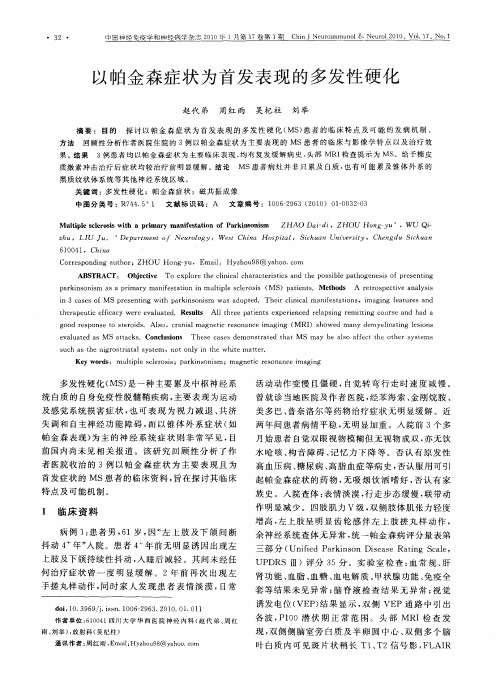
质 激 素 冲 击 治疗 后 症 状 均 较 治疗 前 明显 缓 解 。结 论 黑质纹状体系统等其他神经系统区域 。
MS患 者 病 灶 并 非 只 累及 白质 , 有 可 能 累 及 锥 体 外 系 的 也
关 键 词 : 发 性 硬 化 ;帕 金 森 症 状 ;磁 共 振 成 像 多
中 图分 类 号 : 7 4 5 文献 标 识 码 :A 文 章 编 号 :1 0 9 3( 0 0 10 3 —3 R 4 . 1 0 6 2 6 2 1 )0 — 0 20
Co rs o dn uh r re p n ig a t o :ZHOU n — u, E i: H y h u 8 y h o c m Ho g y mal zo 9 @ a o .o
AB T S RAC Ob et e To e po et eciia c aa trsisa dt ep s il p to e e i o rs nig T: jci v x lr h l c l h rceit n h o sbe ab g n ss fp e e t n c n
中国神经免疫学和神经病学杂志 21 年 1 00 月第 1 卷第 塑 c i 7 h
!
望
坠 !!!Байду номын сангаас
! ! ! : :!
以帕金 森 症 状 为 首发 表 现 的多 发性 硬 化
神经系统疾病的病理生理学机制

神经系统疾病的病理生理学机制神经系统疾病涉及到许多不同类型的疾病,其中包括多发性硬化症、帕金森病、阿尔茨海默病等。
这些疾病会影响到神经元、突触和神经传导通路,导致一系列复杂的病理生理学变化。
一、多发性硬化症多发性硬化症是一种自身免疫性疾病,会影响到中枢神经系统。
其病理生理学变化包括神经髓鞘损伤和神经元细胞死亡。
在病变区域,髓鞘的破坏会导致电信号传递的阻碍和神经元变形。
神经元的死亡则会导致神经功能损害,例如思维障碍、肢体运动障碍等。
此外,多发性硬化症还会导致脑组织炎症反应,增加细胞因子和炎症介质水平,进一步破坏神经细胞和突触连接。
二、帕金森病帕金森病是一种退行性神经疾病,主要影响运动系统。
其病理生理学变化包括多巴胺能神经元的死亡和运动控制通路的损伤。
多巴胺能神经元的死亡会导致多巴胺水平的下降,进而导致肌肉僵硬、震颤和身体不协调等症状。
此外,还会导致神经系统的发炎和氧化应激,进一步破坏神经细胞功能。
三、阿尔茨海默病阿尔茨海默病是一种逐渐发展的退行性神经疾病,会影响到记忆和认知。
其病理生理学变化包括神经元死亡、神经元连接断裂与神经系统内过度的神经元化学物质。
神经元死亡会导致认知和记忆功能损害,如易忘、失误等。
神经元连接断裂会影响到神经网络通信,导致不同脑区之间相互影响的能力降低。
过度的神经元化学物质会导致神经元过度激活,增加神经元死亡的风险。
四、病毒感染引起的神经系统疾病病毒感染也是一个常见的神经系统疾病的诱因。
例如,带状疱疹病毒可以引发带状疱疹和带状疱疹后神经痛等神经系统疾病。
病毒和细菌感染会导致炎症和免疫反应,破坏神经元和突触连接。
此外,病毒感染还可以直接侵入神经系统组织,影响神经元编码和传递信息的能力。
总之,神经系统疾病的病理生理学机制是复杂的,涉及到多个细胞类型和分布广泛的神经系统结构。
这些疾病的治疗需要综合考虑病理生理学的变化,采用相应的治疗手段来保护和恢复神经系统的功能。
神经内科病人的饮食指导与营养支持
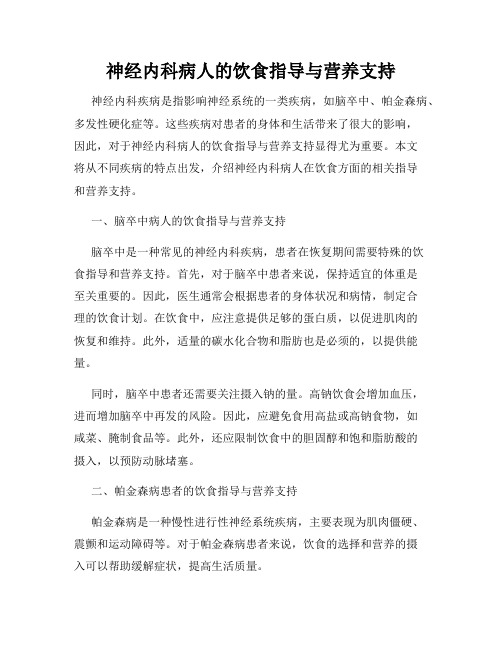
神经内科病人的饮食指导与营养支持神经内科疾病是指影响神经系统的一类疾病,如脑卒中、帕金森病、多发性硬化症等。
这些疾病对患者的身体和生活带来了很大的影响,因此,对于神经内科病人的饮食指导与营养支持显得尤为重要。
本文将从不同疾病的特点出发,介绍神经内科病人在饮食方面的相关指导和营养支持。
一、脑卒中病人的饮食指导与营养支持脑卒中是一种常见的神经内科疾病,患者在恢复期间需要特殊的饮食指导和营养支持。
首先,对于脑卒中患者来说,保持适宜的体重是至关重要的。
因此,医生通常会根据患者的身体状况和病情,制定合理的饮食计划。
在饮食中,应注意提供足够的蛋白质,以促进肌肉的恢复和维持。
此外,适量的碳水化合物和脂肪也是必须的,以提供能量。
同时,脑卒中患者还需要关注摄入钠的量。
高钠饮食会增加血压,进而增加脑卒中再发的风险。
因此,应避免食用高盐或高钠食物,如咸菜、腌制食品等。
此外,还应限制饮食中的胆固醇和饱和脂肪酸的摄入,以预防动脉堵塞。
二、帕金森病患者的饮食指导与营养支持帕金森病是一种慢性进行性神经系统疾病,主要表现为肌肉僵硬、震颤和运动障碍等。
对于帕金森病患者来说,饮食的选择和营养的摄入可以帮助缓解症状,提高生活质量。
第一,帕金森病患者应保持充足的蛋白质摄入。
蛋白质是维持肌肉功能和修复组织的重要营养素,对于帕金森病患者来说尤为重要。
但是,过多的蛋白质摄入也可能干扰药物对身体的吸收和利用,因此,应根据医生的建议合理安排饮食。
第二,帕金森病患者还应摄入足够的纤维。
纤维有助于保持肠道的正常运转,防止便秘和消化不良。
常见的富含纤维的食物有水果、蔬菜、全谷类等。
此外,帕金森病患者还应多摄入富含维生素B6和镁的食物,以缓解症状。
三、多发性硬化症患者的饮食指导与营养支持多发性硬化症是一种免疫介导的神经系统疾病,主要影响中枢神经系统,导致肌力减退、感觉障碍等症状。
对于多发性硬化症患者来说,合理的饮食指导和营养支持可以帮助调节免疫系统、维持健康状况。
nd疾病名词解释(一)
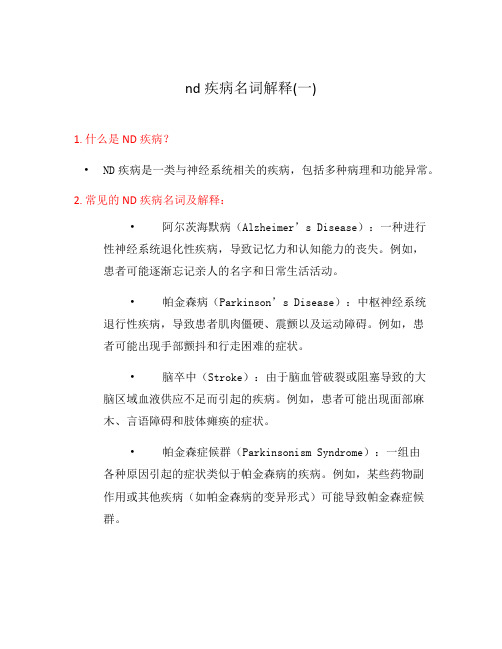
nd疾病名词解释(一)1. 什么是ND疾病?•ND疾病是一类与神经系统相关的疾病,包括多种病理和功能异常。
2. 常见的ND疾病名词及解释:•阿尔茨海默病(Alzheimer’s Disease):一种进行性神经系统退化性疾病,导致记忆力和认知能力的丧失。
例如,患者可能逐渐忘记亲人的名字和日常生活活动。
•帕金森病(Parkinson’s Disease):中枢神经系统退行性疾病,导致患者肌肉僵硬、震颤以及运动障碍。
例如,患者可能出现手部颤抖和行走困难的症状。
•脑卒中(Stroke):由于脑血管破裂或阻塞导致的大脑区域血液供应不足而引起的疾病。
例如,患者可能出现面部麻木、言语障碍和肢体瘫痪的症状。
•帕金森症候群(Parkinsonism Syndrome):一组由各种原因引起的症状类似于帕金森病的疾病。
例如,某些药物副作用或其他疾病(如帕金森病的变异形式)可能导致帕金森症候群。
•亨廷顿舞蹈病(Huntington’s Disease):遗传性神经系统疾病,导致运动、认知和行为的障碍。
例如,患者可能出现不自主的舞蹈样动作、认知功能下降和情绪不稳定的症状。
•多发性硬化症(Multiple Sclerosis,简称MS):一种自身免疫性疾病,影响中枢神经系统。
例如,患者可能经历感觉和运动障碍、视力受损以及疲劳等症状。
•渐冻人综合症(ALS,即肌萎缩侧索硬化症):一种进展性神经肌肉疾病,导致肌肉无力和萎缩。
例如,患者可能逐渐丧失肌肉控制能力,导致肢体无法运动和言语困难。
•格林-巴利综合症(Guillain-Barre Syndrome):一种罕见的自身免疫疾病,主要影响神经系统。
例如,患者可能出现感觉异常、肌肉无力和脚趾和手指麻木的症状。
•帕金森变异性(Parkinsonism Variants):一类疾病,其症状类似于帕金森病,但与其不同的病因和病理机制相关。
例如,多系统萎缩(MSA)和普罗卡齐恩体病(PSP)等都是帕金森变异性。
神经内科学知识点

神经内科学知识点神经内科学是医学的一个分支,主要研究神经系统的疾病,包括脑、脊髓、周围神经和神经肌肉接头等方面的疾病。
下面将介绍一些神经内科学的知识点。
一、脑卒中脑卒中是指突发性脑血管意外,造成脑血管的急性缺血或出血性病变。
常见的症状包括突发性头痛、嘴歪眼斜、肢体无力等。
脑卒中应该尽早就诊,并接受头部CT或MRI检查,确定病变类型,以便制定合理的治疗方案。
二、帕金森病帕金森病是一种慢性进行性疾病,以静止性震颤、肌肉强直、运动迟缓等为主要症状。
该病的病因尚不明确,目前主要通过药物治疗和物理治疗来缓解症状,有时候还需要外科手术治疗。
三、脑膜炎脑膜炎是由细菌、病毒、真菌等感染脑膜组织引起的疾病。
患者常表现为高热、头痛、呕吐、意识障碍等症状。
治疗上应该及时使用抗生素、抗病毒药物等进行治疗,预防并发症的发生。
四、癫痫癫痫是一种常见的神经系统疾病,患者会出现反复发作的癫痫发作。
治疗上主要通过抗癫痫药物来控制症状,部分患者还需要进行手术治疗,切除病变部位。
五、多发性硬化多发性硬化是一种自身免疫性疾病,主要累及中枢神经系统。
患者表现为多发性的中枢神经系统损害症状,包括感觉障碍、运动障碍等。
治疗上主要通过激素治疗和免疫调节剂来控制病情。
六、脑肿瘤脑肿瘤是指生长在脑组织中的一类瘤,可以分为原发性和继发性两种。
临床上常表现为头痛、呕吐、意识障碍等症状。
治疗上主要通过手术切除、放疗和化疗等综合治疗手段来控制病情。
以上就是关于神经内科学的一些知识点,希望对大家有所帮助。
神经内科学是一个广阔而又复杂的领域,需要医务人员不断学习和提升专业技能,为神经系统疾病的治疗提供更好的服务。
祝愿所有患者早日康复!。
神经疾病导致的神经元死亡的机理研究

神经疾病导致的神经元死亡的机理研究神经疾病是指被破坏或改变了神经组织结构和功能的一类疾病,如阿尔茨海默病、帕金森病、多发性硬化症等。
这些疾病的共同点是导致神经元死亡,从而影响神经系统的功能。
因此,研究神经疾病导致的神经元死亡的机理对于疾病的治疗和预防具有重要意义。
神经元死亡是由多种因素引起的,包括兴奋性毒性、细胞凋亡、氧化应激等。
其中,兴奋性毒性是最为常见的一种。
神经元在工作时需要释放神经递质,而过量的神经递质会对神经元产生毒性作用,造成神经元死亡。
例如,帕金森病的发病机理与多巴胺神经元死亡有关。
多巴胺神经元是运动控制和情绪调节的关键神经元,而帕金森病会导致多巴胺神经元数量减少,从而引起肢体僵硬、震颤等症状。
细胞凋亡也是导致神经元死亡的重要机制。
凋亡是一种正常的细胞死亡方式,它与细胞的生长、发育和代谢密切相关。
在神经系统中,细胞凋亡是一种保护性机制,可用来清除有问题的神经元,并维持神经系统的稳态。
然而,在某些疾病中,细胞凋亡会变得过度或异常,导致神经元数量的大量减少。
例如,阿尔茨海默病的发病机制涉及神经元凋亡,它会引起神经元内的tau蛋白异常聚集和β淀粉样蛋白的沉积,从而导致神经元凋亡和认知功能的损失。
氧化应激是另一种导致神经元死亡的机制。
氧化应激是指细胞内自由基(ROS)或反应性氮物质(RNS)超过细胞清除机制的能力所导致的一种累积现象。
在神经系统中,大量的氧化应激会导致神经元膜的氧化损伤和线粒体功能不良,从而引起神经元死亡。
多发性硬化症是一种典型的氧化应激性神经疾病,它的发病机制涉及脊髓和脑神经纤维的炎症和氧化应激反应,导致神经元死亡和脱髓鞘。
总体而言,神经疾病导致的神经元死亡是复杂的、多因素的过程。
它不仅涉及兴奋性毒性、细胞凋亡和氧化应激等机制,还和许多因素如遗传、环境和压力等有关。
因此,探究神经元死亡的机理必须从多个维度入手,建立全面的研究体系,以期为神经疾病的治疗和预防提供更为有效的策略。
神经退行性疾病的诊断与治疗研究
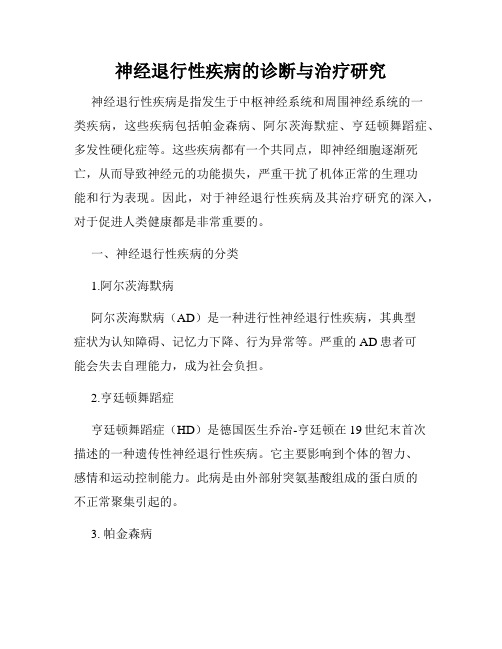
神经退行性疾病的诊断与治疗研究神经退行性疾病是指发生于中枢神经系统和周围神经系统的一类疾病,这些疾病包括帕金森病、阿尔茨海默症、亨廷顿舞蹈症、多发性硬化症等。
这些疾病都有一个共同点,即神经细胞逐渐死亡,从而导致神经元的功能损失,严重干扰了机体正常的生理功能和行为表现。
因此,对于神经退行性疾病及其治疗研究的深入,对于促进人类健康都是非常重要的。
一、神经退行性疾病的分类1.阿尔茨海默病阿尔茨海默病(AD)是一种进行性神经退行性疾病,其典型症状为认知障碍、记忆力下降、行为异常等。
严重的AD患者可能会失去自理能力,成为社会负担。
2.亨廷顿舞蹈症亨廷顿舞蹈症(HD)是德国医生乔治-亨廷顿在19世纪末首次描述的一种遗传性神经退行性疾病。
它主要影响到个体的智力、感情和运动控制能力。
此病是由外部射突氨基酸组成的蛋白质的不正常聚集引起的。
3. 帕金森病帕金森病(PD)是一种运动系统退行性疾病,表现为运动控制失调,剧烈的震颤、僵硬以及运动迟缓等症状。
此病是由于丧失脑内多巴胺(A dopaminergic)神经元的数目造成的。
4.多发性硬化症多发性硬化症(MS)是一种中枢神经系统疾病,表现为全身和运动障碍、感觉障碍等症状,同时还有运动神经元病变和灰质损失。
二、神经退行性疾病的诊断1.家族史询问对于某些神经退行性疾病,例如亨廷顿舞蹈症,家族史是确定诊断的重要依据。
在许多神经退行性疾病患者中,超过10%的受到疾病影响患者的亲属也出现了类似的症状。
2.临床表现临床表现是诊断神经退行性疾病的重要标记,具体表现包括但不限于视力丧失、震颤、行为异常、认知障碍等。
3.分子生物学分析在一些特定的神经退行性疾病中,如亨廷顿舞蹈症、肌萎缩性侧索硬化症等,可能存在某些特定的基因突变引起的,因此在这些病例中应进行基因分析。
4.影像学检查神经影像学检查,如核磁共振成像(MRI)等,对于神经退行性疾病的诊断也是非常有帮助的。
MRI能够检测出透明外质、重复运动性损伤等,还能观察到深内侧核等神经核的异常。
神经系统疾病

神经系统疾病神经系统是人体重要的调节和控制系统,但它也容易受到各种疾病的影响。
神经系统疾病是指那些影响神经组织和神经功能的疾病,包括神经退行性疾病、神经炎症性疾病和神经肿瘤等。
一、神经退行性疾病1. 阿尔茨海默病阿尔茨海默病是老年人中最常见的神经退行性疾病。
其特征是大脑神经细胞的逐渐退化和死亡,导致记忆力、思维能力和行动能力的丧失。
阿尔茨海默病的早期症状包括记忆力下降、注意力不集中、迷失方向等,随着病情的进展,患者会出现言语障碍、认知障碍和行为变化等。
2. 帕金森病帕金森病是一种常见的神经运动障碍性疾病,主要由脑内多巴胺神经元的损失引起。
其症状包括肌肉僵硬、震颤、动作迟缓等。
帕金森病的严重性逐渐加重,严重影响患者的日常生活和生活质量。
二、神经炎症性疾病1. 脊髓灰质炎脊髓灰质炎是由脊髓灰质炎病毒引起的急性传染病,主要通过肠道传播。
其症状包括发热、头痛、呕吐、肌肉无力等,严重时可导致四肢瘫痪和呼吸肌麻痹。
2. 多发性硬化症多发性硬化症是一种自身免疫性疾病,主要影响中枢神经系统的脑和脊髓。
多发性硬化症的症状多种多样,包括视力模糊、肢体无力、平衡障碍等。
病情逐渐加重,可导致行动困难和身体功能障碍。
三、神经肿瘤1. 脑肿瘤脑肿瘤是指在脑组织中发生的肿瘤,其种类繁多。
脑肿瘤的症状取决于肿瘤的位置和大小,常见症状包括头痛、恶心、呕吐、意识改变等。
脑肿瘤的治疗方法包括手术切除、放疗和化疗等。
2. 神经纤维瘤神经纤维瘤是一种起源于神经鞘细胞的良性肿瘤,常见于神经系统的周边神经。
神经纤维瘤的症状包括局部皮肤颜色改变、肿块感、疼痛、神经功能障碍等。
治疗方法包括手术切除和放疗等。
综上所述,神经系统疾病是一类严重影响人们生活质量和健康的疾病。
了解其症状和治疗方法对于预防和治疗神经系统疾病具有重要意义。
鉴于每种疾病的特点不同,患者在面临疑似神经系统疾病时,应及时就医并接受专业医生的诊断和治疗。
神经病学名词解释
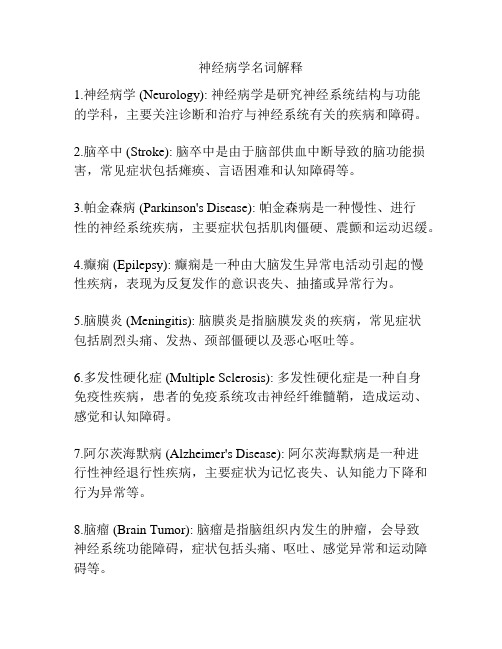
神经病学名词解释
1.神经病学 (Neurology): 神经病学是研究神经系统结构与功能
的学科,主要关注诊断和治疗与神经系统有关的疾病和障碍。
2.脑卒中 (Stroke): 脑卒中是由于脑部供血中断导致的脑功能损害,常见症状包括瘫痪、言语困难和认知障碍等。
3.帕金森病 (Parkinson's Disease): 帕金森病是一种慢性、进行
性的神经系统疾病,主要症状包括肌肉僵硬、震颤和运动迟缓。
4.癫痫 (Epilepsy): 癫痫是一种由大脑发生异常电活动引起的慢
性疾病,表现为反复发作的意识丧失、抽搐或异常行为。
5.脑膜炎 (Meningitis): 脑膜炎是指脑膜发炎的疾病,常见症状
包括剧烈头痛、发热、颈部僵硬以及恶心呕吐等。
6.多发性硬化症 (Multiple Sclerosis): 多发性硬化症是一种自身
免疫性疾病,患者的免疫系统攻击神经纤维髓鞘,造成运动、感觉和认知障碍。
7.阿尔茨海默病 (Alzheimer's Disease): 阿尔茨海默病是一种进
行性神经退行性疾病,主要症状为记忆丧失、认知能力下降和行为异常等。
8.脑瘤 (Brain Tumor): 脑瘤是指脑组织内发生的肿瘤,会导致
神经系统功能障碍,症状包括头痛、呕吐、感觉异常和运动障碍等。
9.脊髓损伤 (Spinal Cord Injury): 脊髓损伤是指脊髓受到外力损伤,造成下半身瘫痪、感觉丧失和膀胱功能障碍等症状。
10.神经退行性疾病 (Neurodegenerative Disease): 神经退行性疾病是一类疾病,其特征是神经细胞逐渐死亡或退化,例如帕金森病和阿尔茨海默病。
病理学复习重点神经系统疾病的病理学机制

病理学复习重点神经系统疾病的病理学机制神经系统疾病是指影响人体神经细胞和神经组织功能的各种疾病。
病理学是研究疾病的本质和机制的学科,对于理解和诊治神经系统疾病具有重要意义。
本文将重点介绍神经系统疾病的病理学机制,以帮助读者更好地进行病理学的复习。
一、脑卒中脑卒中是指脑血管破裂或阻塞导致脑部缺血或出血的疾病。
主要包括缺血性脑卒中和出血性脑卒中两种类型。
缺血性脑卒中常见的病理学机制是动脉粥样硬化,即血管壁发生脂质沉积和纤维组织增生,导致血管狭窄和阻塞。
出血性脑卒中的主要机制是血管壁脆性增加或破裂。
二、帕金森病帕金森病是一种慢性进行性运动障碍疾病,主要表现为肌张力增高、静止性震颤和运动缓慢。
其病理学机制是黑质多巴胺能神经元减少,黑质嗜酪碱性神经元空泡内透明颗粒异常聚积,导致多巴胺合成和释放减少。
三、阿尔茨海默病阿尔茨海默病是一种进行性神经退行性疾病,以认知功能障碍为主要表现。
其病理学机制是神经纤维缠结、神经细胞内含有异常蛋白质的沉积,以及神经元丧失和突触损失。
四、脊髓损伤脊髓损伤是指脊髓各个部位的功能障碍或丧失,其病理学机制是脊髓损伤部位的神经元和神经纤维受到机械性损伤和缺血性损伤,导致细胞死亡和轴突断裂。
五、多发性硬化症多发性硬化症是一种以中枢神经系统炎症和脱髓鞘为特征的自身免疫性疾病。
其病理学机制是免疫系统异常攻击神经元和神经纤维,导致脱髓鞘和炎症细胞浸润。
六、癫痫癫痫是一种反复发作性脑部神经元异常放电引起的慢性疾病。
其病理学机制是神经元过度兴奋和异常放电,导致脑部神经网络的不适应性改变。
七、脑肿瘤脑肿瘤是指脑部组织内的肿瘤,可以分为原发性脑肿瘤和继发性脑肿瘤。
其病理学机制是细胞异常增殖和凋亡失调,导致肿瘤形成。
总结起来,神经系统疾病的病理学机制是多方面的,涉及到细胞损伤、神经元功能异常、炎症反应等多个方面。
通过深入了解和研究疾病的病理学机制,可以为神经系统疾病的诊断和治疗提供科学依据。
神经内科常见护理及护理措施

神经内科常见护理及护理措施神经内科是专门研究神经系统疾病的科学,常见的神经内科疾病包括脑卒中、帕金森病、癫痫、脑外伤、多发性硬化症等。
针对这些疾病,以下是常见的护理及护理措施:1. 脑卒中的护理:- 确保患者的呼吸道通畅,防止窒息。
- 维持患者的稳定体温、血压和血糖水平。
- 力促患者进行康复训练,包括肌力和功能恢复训练。
- 提供口腔护理,预防吞咽困难或感染。
2. 帕金森病的护理:- 协助患者进行日常生活活动,如洗澡、进食等。
- 鼓励患者进行物理活动,如散步、抖动等。
- 保持环境安静,避免干扰。
- 帮助患者调整姿势,确保安全,防止跌倒。
3. 癫痫的护理:- 观察癫痫发作时的表现,及时采取措施保护患者的头部和四肢。
- 给予需要的药物治疗。
- 维护患者的安全和舒适,预防伤害。
- 提供心理支持,帮助患者应对癫痫带来的不良情绪和心理影响。
4. 脑外伤的护理:- 跟踪观察患者的神经症状和体征。
- 确保患者的呼吸道通畅。
- 进行头部CT扫描或MRI等检查,评估损伤程度。
- 给予适当的药物治疗,如止痛药或抗炎药。
- 提供情绪支持,帮助患者恢复。
5. 多发性硬化症的护理:- 协助患者进行肌力和康复训练,帮助恢复功能。
- 提供足够的休息和睡眠。
- 管理病症,如控制疼痛和抑郁等。
- 提供营养和饮食建议,保持身体健康。
此外,无论是哪种神经内科疾病,护理人员应密切观察患者的病情变化,及时报告医生,并为患者提供心理支持和教育。
护理过程中,注意保持患者的隐私和尊严,提供舒适和安全的护理环境。
神经内科常见疾病并发症

神经内科常见疾病并发症神经内科是专注于神经系统疾病的医学领域,常见疾病包括脑卒中、癫痫、帕金森病等。
这些疾病给患者的身体和生活带来了很大的困扰,同时也会引发一系列的并发症。
本文将介绍神经内科常见疾病及其相关并发症,以增加人们对这些疾病的认识和理解。
一、脑卒中及其并发症脑卒中是指脑血管发生破裂或者阻塞,导致脑部供血不足,继而引发脑组织损伤的一类疾病。
脑卒中的常见并发症包括语言障碍、肢体功能障碍等。
脑卒中后患者在恢复期间需要进行康复治疗,以恢复受损的神经功能。
二、癫痫及其并发症癫痫是一种由于大脑神经元过度放电引起的慢性疾病,患者会出现反复发作的癫痫发作。
癫痫发作可能导致意识丧失、肢体抽动等症状。
长期癫痫发作还可能导致认知功能下降、精神障碍等并发症。
三、帕金森病及其并发症帕金森病是一种中枢神经系统退行性疾病,主要表现为肌肉僵硬、震颤、运动缓慢等症状。
帕金森病的并发症包括抑郁、认知功能障碍等,严重影响患者的生活质量。
四、脑膜炎及其并发症脑膜炎是指脑膜及其周围组织的炎症反应。
常见病因包括细菌感染、病毒感染等。
脑膜炎的并发症主要有颅内感染、神经系统损伤等,需要及时治疗以防止严重后果。
五、脑炎及其并发症脑炎是指脑组织的炎症反应,通常由病毒感染引起。
脑炎的并发症有意识障碍、神经功能缺损、癫痫等。
脑炎对患者的身体和神经系统带来持久不良影响,治疗应早期进行。
六、多发性硬化症及其并发症多发性硬化症是一种以波及中枢神经系统为特征的慢性、进行性疾病。
常见并发症包括运动障碍、感觉异常、认知障碍等。
多发性硬化症给患者带来了很大的身心困扰,需要综合治疗来缓解症状。
总结:以上是神经内科常见疾病的并发症,包括脑卒中、癫痫、帕金森病、脑膜炎、脑炎以及多发性硬化症。
这些疾病给患者的身体和生活带来了很大的困扰,同时也会引发一系列的并发症。
正确的诊断和有效的治疗可以帮助患者减轻症状和并发症的影响,提高生活质量。
但是,预防为主仍然是解决这些疾病及其并发症问题的关键,我们应该加强对这些疾病的宣传和教育,注意生活习惯,定期体检,及时就诊,降低罹患这些疾病的风险。
神经内科简答题

神经内科简答题
神经内科简答题
神经内科是以神经系统疾病的诊断、治疗和预防为主要任务的临床学科。
下面是一些常见的神经内科简答题:
一、什么是脑出血?
答:脑出血是指颅内血管破裂,血液向脑组织内溢出,引起局部脑组
织损伤或死亡。
脑出血的原因包括高血压、动静脉畸形、脑动脉瘤、
血液病等。
二、什么是帕金森病?
答:帕金森病是一种慢性进行性的神经系统疾病,主要的症状是肢体
僵硬、震颤、运动缓慢、姿势不稳、面部表情淡漠等。
帕金森病的病
因尚不清楚,目前认为与基因、环境、神经元的退化等多种因素有关。
三、什么是多发性硬化?
答:多发性硬化是一种中枢神经系统慢性疾病,影响脑、脊髓和视神
经等部位。
其主要症状包括运动和感觉障碍、视觉问题、疲劳、肌肉弱点等。
多发性硬化的病因目前尚不明确。
四、什么是脑膜炎?
答:脑膜炎是指脑膜(即脑的保护层)的炎症。
脑膜炎的症状包括头痛、发热、恶心、呕吐、颈项强直、皮肤发红等。
常见的病因包括病毒感染、细菌感染、真菌感染等。
五、什么是脑脊液检查?
答:脑脊液检查是一种通过采集脑脊液样本来检测某些疾病的方法。
采集脑脊液是通过腰穿来实现的,医生会穿刺患者的腰椎区域,将针头插入脊髓腔内并采集脑脊液样本。
脑脊液检查可用于诊断多种神经系统疾病,如脑膜炎、多发性硬化、脑肿瘤等。
以上是一些常见的神经内科简答题,希望对大家有所帮助。
神经内科疾病复杂多样,如果有相关症状,及时就医是非常重要的。
神经系统疾病的靶向治疗策略
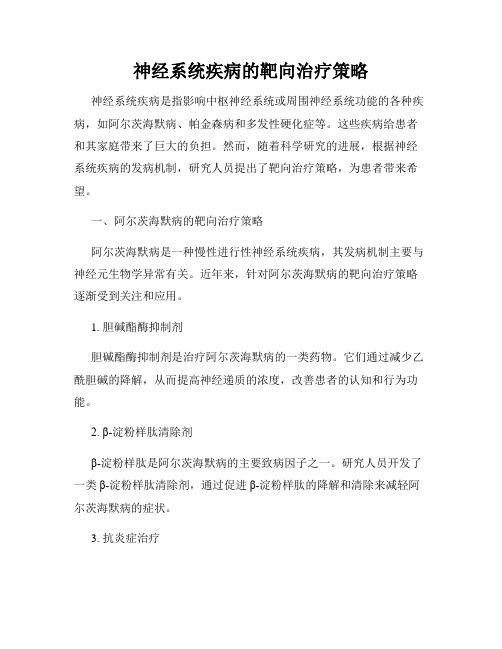
神经系统疾病的靶向治疗策略神经系统疾病是指影响中枢神经系统或周围神经系统功能的各种疾病,如阿尔茨海默病、帕金森病和多发性硬化症等。
这些疾病给患者和其家庭带来了巨大的负担。
然而,随着科学研究的进展,根据神经系统疾病的发病机制,研究人员提出了靶向治疗策略,为患者带来希望。
一、阿尔茨海默病的靶向治疗策略阿尔茨海默病是一种慢性进行性神经系统疾病,其发病机制主要与神经元生物学异常有关。
近年来,针对阿尔茨海默病的靶向治疗策略逐渐受到关注和应用。
1. 胆碱酯酶抑制剂胆碱酯酶抑制剂是治疗阿尔茨海默病的一类药物。
它们通过减少乙酰胆碱的降解,从而提高神经递质的浓度,改善患者的认知和行为功能。
2. β-淀粉样肽清除剂β-淀粉样肽是阿尔茨海默病的主要致病因子之一。
研究人员开发了一类β-淀粉样肽清除剂,通过促进β-淀粉样肽的降解和清除来减轻阿尔茨海默病的症状。
3. 抗炎症治疗越来越多的研究表明,神经系统炎症在阿尔茨海默病的发展中起到重要作用。
因此,抗炎症治疗成为一种有前景的靶向治疗策略。
抗炎症药物可以减少炎症反应,从而改善神经系统功能。
二、帕金森病的靶向治疗策略帕金森病是一种主要由多巴胺能神经元丧失引起的运动障碍性疾病。
靶向治疗策略对于帕金森病的早期诊断和干预具有重要作用。
1. 多巴胺激动剂多巴胺激动剂可以增加脑内多巴胺的水平,补充缺失的多巴胺神经元,从而改善患者的运动功能。
2. 深部脑刺激深部脑刺激是一种通过植入电极并刺激特定脑区的方法。
它可以改善帕金森病患者的运动症状和生活质量。
3. 抗氧化治疗研究发现,帕金森病与氧化应激和氧自由基相关。
因此,抗氧化治疗成为一种有前景的靶向治疗策略,可以减少氧自由基的产生,从而减轻帕金森病的症状。
三、多发性硬化症的靶向治疗策略多发性硬化症是一种免疫介导的疾病,主要累及神经髓鞘和中枢神经系统。
近年来,多发性硬化症的靶向治疗策略受到广泛关注并取得了一定的进展。
1. 免疫调节剂免疫调节剂可以调整免疫系统的功能,减少自身免疫反应对神经系统的破坏。
中枢神经系统疾病的症状与治疗
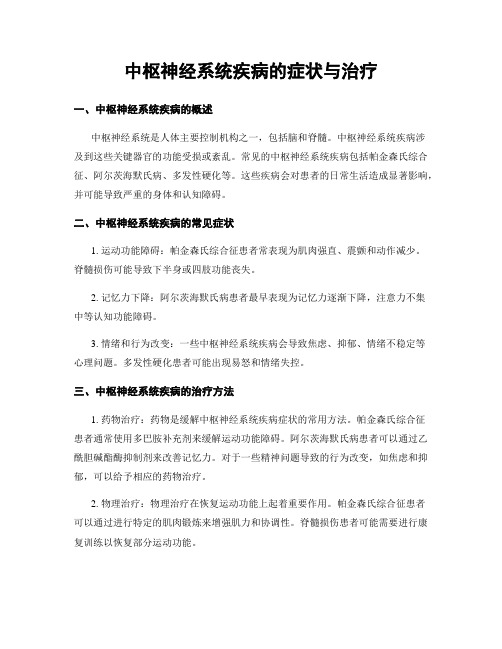
中枢神经系统疾病的症状与治疗一、中枢神经系统疾病的概述中枢神经系统是人体主要控制机构之一,包括脑和脊髓。
中枢神经系统疾病涉及到这些关键器官的功能受损或紊乱。
常见的中枢神经系统疾病包括帕金森氏综合征、阿尔茨海默氏病、多发性硬化等。
这些疾病会对患者的日常生活造成显著影响,并可能导致严重的身体和认知障碍。
二、中枢神经系统疾病的常见症状1. 运动功能障碍:帕金森氏综合征患者常表现为肌肉强直、震颤和动作减少。
脊髓损伤可能导致下半身或四肢功能丧失。
2. 记忆力下降:阿尔茨海默氏病患者最早表现为记忆力逐渐下降,注意力不集中等认知功能障碍。
3. 情绪和行为改变:一些中枢神经系统疾病会导致焦虑、抑郁、情绪不稳定等心理问题。
多发性硬化患者可能出现易怒和情绪失控。
三、中枢神经系统疾病的治疗方法1. 药物治疗:药物是缓解中枢神经系统疾病症状的常用方法。
帕金森氏综合征患者通常使用多巴胺补充剂来缓解运动功能障碍。
阿尔茨海默氏病患者可以通过乙酰胆碱酯酶抑制剂来改善记忆力。
对于一些精神问题导致的行为改变,如焦虑和抑郁,可以给予相应的药物治疗。
2. 物理治疗:物理治疗在恢复运动功能上起着重要作用。
帕金森氏综合征患者可以通过进行特定的肌肉锻炼来增强肌力和协调性。
脊髓损伤患者可能需要进行康复训练以恢复部分运动功能。
3. 心理治疗:心理治疗可以帮助中枢神经系统疾病患者应对心理压力和情绪问题。
认知行为治疗等方法可以帮助患者调整态度,学会应对困境。
4. 手术治疗:对于一些严重的中枢神经系统疾病如脑肿瘤或癫痫,手术可能是唯一有效的治疗方法。
手术可以去除异常组织或缓解受压神经。
四、中枢神经系统疾病的预防与饮食1. 健康生活方式:坚持健康的生活方式是预防中枢神经系统疾病的重要措施。
包括适当的锻炼、充足的睡眠、合理饮食和减少精神压力等。
2. 营养均衡:饮食对中枢神经系统健康也起到很大影响。
摄入足够的维生素B 族和ω-3脂肪酸,例如通过多吃富含这些成分的食物如鱼类、坚果和豆类来促进脑功能。
这5种病不是癌却比癌症还可怕

这5种病不是癌却比癌症还可怕这5种疾病比癌症还可怕在我们生活中,癌症一直被看作是一种可怕的疾病,它带给人们痛苦和恐惧。
然而,除了癌症,还有一些其他疾病同样令人生畏。
本文将介绍这5种疾病,它们虽然不是癌症,却同样可怕。
首先,帕金森病是一种神经系统的慢性疾病,通常会导致肢体的颤抖、僵硬和运动功能障碍等症状。
这种疾病的可怕之处在于,它会逐渐影响患者的行动能力,使他们生活质量严重下降。
同时,帕金森病也会给患者带来心理压力和抑郁情绪,对他们的身心健康造成困扰。
其次,阿尔茨海默病是一种与老年相关的退行性疾病,常常导致记忆力丧失、思维能力下降和智力衰退等症状。
这种疾病的可怕之处在于,它会剥夺患者与亲友们的交流能力,使他们逐渐失去自我意识和日常生活的技巧。
患有阿尔茨海默病的人需要长期的护理和照顾,这对他们的家庭和社会来说都是一项巨大的负担。
第三,帕尔金森松弛症是一种罕见的进行性肌肉退化疾病,常常导致肢体无力、肌肉萎缩和运动障碍等症状。
这种疾病的可怕之处在于,它会使患者变得完全无法行动,甚至连简单的日常活动都变得困难。
与癌症不同,帕尔金森松弛症无法通过手术或放疗等治疗手段来治愈,患者只能接受康复训练和辅助设备的支持。
第四,重症肌无力是一种自身免疫性疾病,会导致肌肉无力、疲劳和运动障碍等症状。
这种疾病的可怕之处在于,它可能导致患者突然丧失肌肉力量,甚至无法行动、呼吸困难等。
重症肌无力患者需要长期接受药物治疗以控制病情,同时也需要经常进行医学检查以避免并发症的发生。
最后,多发性硬化症是一种神经系统的慢性疾病,常常导致不同部位的神经损伤和功能障碍。
这种疾病的可怕之处在于,它会对患者的运动、感觉和认知能力产生严重影响,甚至导致残疾。
多发性硬化症的治疗较为复杂,患者需要长期接受药物治疗和康复训练,以维持其生活的基本功能。
综上所述,虽然癌症一直被视为最可怕的疾病之一,但我们不能忽视其他一些同样令人恐惧的疾病。
帕金森病、阿尔茨海默病、帕尔金森松弛症、重症肌无力和多发性硬化症,它们给患者的生活带来了巨大的困扰和挑战。
神经退行性疾病的发病机制和治疗策略

神经退行性疾病的发病机制和治疗策略神经退行性疾病,指的是由于神经细胞的退化和死亡而导致的神经系统功能障碍。
常见的神经退行性疾病包括阿尔茨海默病、帕金森病、亨廷顿病和多发性硬化等。
这些疾病的发病率逐年上升,成为威胁人类健康和生命的重要问题。
本文将结合神经退行性疾病的不同类型,探讨其发病机制和治疗策略。
1.阿尔茨海默病(Alzheimer's Disease)阿尔茨海默病是一种以认知障碍为主要特征的神经退行性疾病,常发生在老年人群体中。
其发病机制主要涉及Tau蛋白异常聚集和β淀粉样蛋白堆积两个方面。
Tau蛋白是一种神经元细胞骨架的主要成分,它的异常聚集可以导致神经元连接的损失和代谢功能的异常。
β淀粉样蛋白是一种在神经元周围堆积的物质,其积累会导致神经元死亡和功能障碍。
此外,炎症和氧化应激也与阿尔茨海默病的发病有关。
治疗策略主要包括抗胆碱酯酶药物、针对Tau蛋白和β淀粉样蛋白的抗体疗法、神经营养素的补充和干细胞治疗等。
2.帕金森病(Parkinson's Disease)帕金森病是一种常见的运动障碍性神经退行性疾病,其特征是黑质多巴胺神经元的死亡和功能异常。
现代研究认为,帕金森病的发病机制主要是多种因素共同作用的结果,包括氧化应激、神经炎性因子的异常分泌、α-突触核蛋白异常沉积等。
治疗策略包括多巴胺激动剂、深部脑刺激、细胞因子治疗和免疫疗法等。
3.亨廷顿病(Huntington's Disease)亨廷顿病是一种由于脑部神经元细胞死亡而导致的运动障碍性神经退行性疾病。
其特征是由CAG三核苷酸重复扩增导致孟氏体蛋白的异常积累,这可以导致免疫系统的激活和神经元凋亡。
前路主要采用药物治疗、基因治疗和细胞治疗等。
4.多发性硬化(Multiple Sclerosis)多发性硬化是一种由于免疫系统失调引起的难治性神经退行性疾病。
其发病机制与自身免疫功能障碍相关,包括免疫细胞和自身抗原的缺陷和异常活化等因素。
神经退行性疾病和神经修复的研究进展
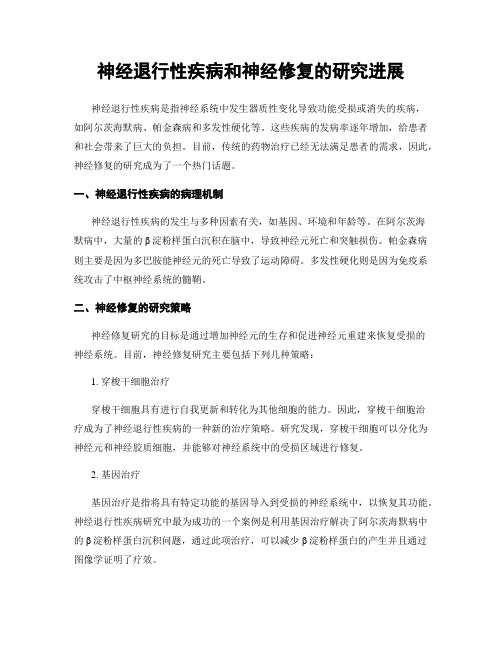
神经退行性疾病和神经修复的研究进展神经退行性疾病是指神经系统中发生器质性变化导致功能受损或消失的疾病,如阿尔茨海默病、帕金森病和多发性硬化等。
这些疾病的发病率逐年增加,给患者和社会带来了巨大的负担。
目前,传统的药物治疗已经无法满足患者的需求,因此,神经修复的研究成为了一个热门话题。
一、神经退行性疾病的病理机制神经退行性疾病的发生与多种因素有关,如基因、环境和年龄等。
在阿尔茨海默病中,大量的β淀粉样蛋白沉积在脑中,导致神经元死亡和突触损伤。
帕金森病则主要是因为多巴胺能神经元的死亡导致了运动障碍。
多发性硬化则是因为免疫系统攻击了中枢神经系统的髓鞘。
二、神经修复的研究策略神经修复研究的目标是通过增加神经元的生存和促进神经元重建来恢复受损的神经系统。
目前,神经修复研究主要包括下列几种策略:1. 穿梭干细胞治疗穿梭干细胞具有进行自我更新和转化为其他细胞的能力。
因此,穿梭干细胞治疗成为了神经退行性疾病的一种新的治疗策略。
研究发现,穿梭干细胞可以分化为神经元和神经胶质细胞,并能够对神经系统中的受损区域进行修复。
2. 基因治疗基因治疗是指将具有特定功能的基因导入到受损的神经系统中,以恢复其功能。
神经退行性疾病研究中最为成功的一个案例是利用基因治疗解决了阿尔茨海默病中的β淀粉样蛋白沉积问题,通过此项治疗,可以减少β淀粉样蛋白的产生并且通过图像学证明了疗效。
3. 免疫治疗免疫治疗是指利用免疫系统中的分子和细胞来增强受损区域的治疗。
多发性硬化的治疗即常常采用这种策略来减轻患者症状。
这种疾病的发病机制是免疫系统误认神经系统成分导致的,因此,利用免疫治疗可以减少组织损伤并提高患者的生命质量。
三、神经修复的前景神经修复在不断地发展中,各种新的治疗策略也在不断地涌现。
神经修复的前景可以归纳为以下几点:1. 将会有更加精准的治疗方法出现,通过单个患者的基因组学分析,精准地鉴定治疗方案。
2. 神经干细胞变为了研究热点,神经干细胞治疗可以在神经系统的重建方面扮演重要的角色。
解读神经内科常见疾病的治疗原则
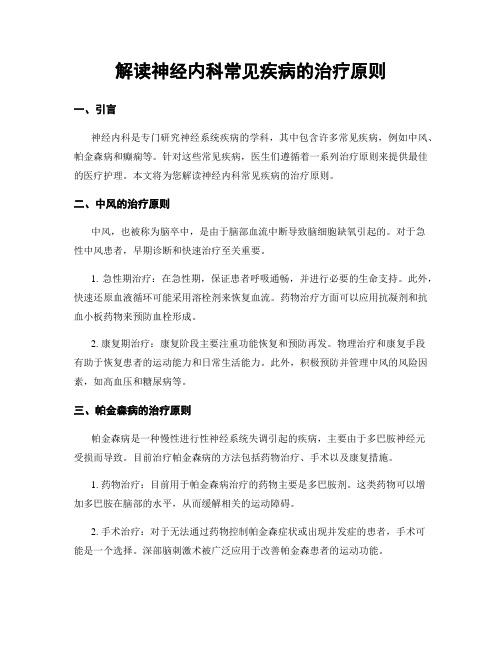
解读神经内科常见疾病的治疗原则一、引言神经内科是专门研究神经系统疾病的学科,其中包含许多常见疾病,例如中风、帕金森病和癫痫等。
针对这些常见疾病,医生们遵循着一系列治疗原则来提供最佳的医疗护理。
本文将为您解读神经内科常见疾病的治疗原则。
二、中风的治疗原则中风,也被称为脑卒中,是由于脑部血流中断导致脑细胞缺氧引起的。
对于急性中风患者,早期诊断和快速治疗至关重要。
1. 急性期治疗:在急性期,保证患者呼吸通畅,并进行必要的生命支持。
此外,快速还原血液循环可能采用溶栓剂来恢复血流。
药物治疗方面可以应用抗凝剂和抗血小板药物来预防血栓形成。
2. 康复期治疗:康复阶段主要注重功能恢复和预防再发。
物理治疗和康复手段有助于恢复患者的运动能力和日常生活能力。
此外,积极预防并管理中风的风险因素,如高血压和糖尿病等。
三、帕金森病的治疗原则帕金森病是一种慢性进行性神经系统失调引起的疾病,主要由于多巴胺神经元受损而导致。
目前治疗帕金森病的方法包括药物治疗、手术以及康复措施。
1. 药物治疗:目前用于帕金森病治疗的药物主要是多巴胺剂。
这类药物可以增加多巴胺在脑部的水平,从而缓解相关的运动障碍。
2. 手术治疗:对于无法通过药物控制帕金森症状或出现并发症的患者,手术可能是一个选择。
深部脑刺激术被广泛应用于改善帕金森患者的运动功能。
3. 康复阶段:康复措施主要包括物理治疗、言语治疗和职业治疗等。
这些康复手段旨在提高患者的生活质量,并帮助他们更好地应对日常生活中的困难。
四、癫痫的治疗原则癫痫是一种慢性神经系统疾病,表现为反复发作的癫痫发作。
主要的治疗目标是控制癫痫发作,减少或消除与之相关的不良影响。
1. 药物治疗:大多数癫痫患者可以通过规律使用抗癫痫药物来控制其发作。
这些药物可以通过调节神经元兴奋性和抑制性来阻断过度放电。
2. 手术治疗: 对于一些无法通过药物控制癫痫发作的患者,手术可能是一个选择。
手术通常会切除引起癫痫发作的异常区域。
浅析导致神经内科疾病患者发生跌倒的危险因素
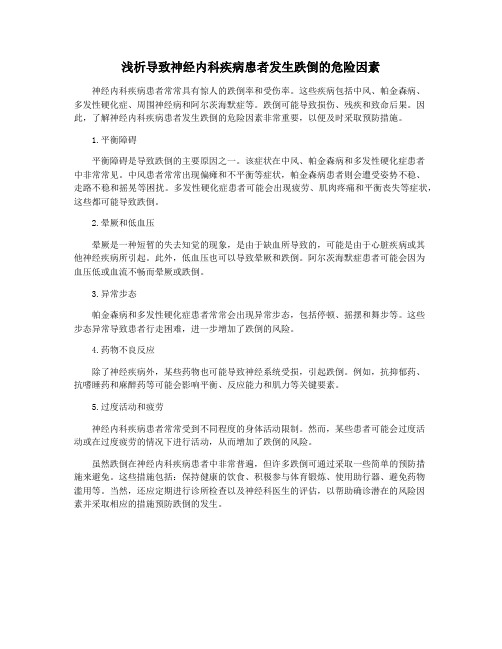
浅析导致神经内科疾病患者发生跌倒的危险因素神经内科疾病患者常常具有惊人的跌倒率和受伤率。
这些疾病包括中风、帕金森病、多发性硬化症、周围神经病和阿尔茨海默症等。
跌倒可能导致损伤、残疾和致命后果。
因此,了解神经内科疾病患者发生跌倒的危险因素非常重要,以便及时采取预防措施。
1.平衡障碍平衡障碍是导致跌倒的主要原因之一。
该症状在中风、帕金森病和多发性硬化症患者中非常常见。
中风患者常常出现偏瘫和不平衡等症状,帕金森病患者则会遭受姿势不稳、走路不稳和摇晃等困扰。
多发性硬化症患者可能会出现疲劳、肌肉疼痛和平衡丧失等症状,这些都可能导致跌倒。
2.晕厥和低血压晕厥是一种短暂的失去知觉的现象,是由于缺血所导致的,可能是由于心脏疾病或其他神经疾病所引起。
此外,低血压也可以导致晕厥和跌倒。
阿尔茨海默症患者可能会因为血压低或血流不畅而晕厥或跌倒。
3.异常步态帕金森病和多发性硬化症患者常常会出现异常步态,包括停顿、摇摆和舞步等。
这些步态异常导致患者行走困难,进一步增加了跌倒的风险。
4.药物不良反应除了神经疾病外,某些药物也可能导致神经系统受损,引起跌倒。
例如,抗抑郁药、抗嗜睡药和麻醉药等可能会影响平衡、反应能力和肌力等关键要素。
5.过度活动和疲劳神经内科疾病患者常常受到不同程度的身体活动限制。
然而,某些患者可能会过度活动或在过度疲劳的情况下进行活动,从而增加了跌倒的风险。
虽然跌倒在神经内科疾病患者中非常普遍,但许多跌倒可通过采取一些简单的预防措施来避免。
这些措施包括:保持健康的饮食、积极参与体育锻炼、使用助行器、避免药物滥用等。
当然,还应定期进行诊所检查以及神经科医生的评估,以帮助确诊潜在的风险因素并采取相应的措施预防跌倒的发生。
- 1、下载文档前请自行甄别文档内容的完整性,平台不提供额外的编辑、内容补充、找答案等附加服务。
- 2、"仅部分预览"的文档,不可在线预览部分如存在完整性等问题,可反馈申请退款(可完整预览的文档不适用该条件!)。
- 3、如文档侵犯您的权益,请联系客服反馈,我们会尽快为您处理(人工客服工作时间:9:00-18:30)。
Research letterParkinson disease and multiple sclerosis are not associated with autoantibodies against structural proteins of the dermal –epidermal junctionDOI:10.1111/bjd.14538D EARE DITOR ,Bullous pemphigoid (BP),the most frequent autoimmune blistering disease,is associated with autoantibod-ies against two proteins of the dermal –epidermal junction (DEJ),BP180(type XVII collagen)and BP230[BP antigen 1(BPAG1)].1Two peculiar clinical features of BP are the advanced age of patients,with a mean age of between 75and 80years at disease onset,and its association with neurological disease.1Neurological diseases can be diagnosed in 30–50%of patients with BP,including cognitive impairment,stroke,epilepsy,Parkinson disease (PD)and multiple sclerosis (MS),with odds ratios (ORs)of 2Á2,1Á8–3Á3,1Á7–4Á0,2Á16–3Á50and 10Á7,respectively.2–7In addition,patients with MS are more likely to develop BP (OR 6Á7).8These findings are par-ticularly intriguing as the cutaneous target antigens of BP –BP180and BP230–are also expressed in the central nervous system (CNS).BP180expression was found in the cerebellum of rats and in autopsy samples of various neuroanatomical regions of human brain.9,10Mice with mutations in the dys-tonin gene encoding for various isoforms of BPAG1,includingthe epithelial isoform BP230,develop severe dystonia and sensory nerve degeneration.11While PD is thought to be a primary neurodegenerative disorder,inflammatory responses seem to be secondary.12,13MS is believed to be initially induced via a peripheral immune response,and further driven by immune reactions within the CNS with secondary neurode-generation.14During the process of neurodegeneration the two BP autoantigens in the CNS may have been exposed to the immune system,leading to the break of tolerance and,subsequently,to the generation of anti-BP180and anti-BP230antibodies,and,finally,to BP.9,15In the present study,according to this hypothesis,we expected to detect serum autoantibodies against BP180and BP230more frequently in patients with PD and MS compared with age-and sex-matched controls.Alternatively,or addition-ally,environmental factors that increase susceptibility to the development of neurological disorders might similarly change the risk of autoimmune blistering dermatoses.8We compared three age-and sex-matched groups of patients with PD (n =75,cohort A1),other neurological diseases [n =75,cohort A2;detailed information is given in Table S1(see Supporting Information)]and healthy controls (n =75,cohort A3)(Table 1).All sera from cohort A were prospec-tively collected and matched for age and sex.Furthermore,prospectively collected sera from consecutive patients with PD at another academic site (L €u beck;n =50,cohort C),a cohortTable 1Overview of serological results©2016British Association of Dermatologists British Journal of Dermatology (2016)1of patients with MS(n=50,cohort D)and patients with non-inflammatory skin diseases and older than75years(n=65, cohort B;Table1)were analysed.Cohort B was included to mirror the age group of patients with BP.To determine the sample sizes necessary to compare the frequency of reactive sera in patients and controls,a power calculation based on Fisher’s exact test was performed.To be clinically relevant,weassumed that the odds of detecting serumautoantibodies inpatients with PD and MS would be increased at leastfive times compared with controls,and that anti-BP180/BP230antibod-ies would be detected in1–2%of controls.16–18Based on these assumptions,the power(p)for detecting significantly different amounts of BP180/BP230-reactive sera between patients with PD/MS(n=175)and controls(n=215)was0Á51–0Á86.To detect reactivity against BP180and BP230,all sera were subjected to a panel of diagnostic assays,including(i)indirect immunofluorescence(IIF)microscopy on a BIOCHIPâmosaic (monkey oesophagus,split human skin,recombinant BP180 NC16A,HEK293expressing the BP180ectodomain,the BP230globular domain and full-length BP230;Euroimmun, L€u beck,Germany);(ii)BP180NC16A-based enzyme-linked immunosorbent assay(ELISA);(iii)BP230-based ELISA(both from Euroimmun);(iv)Western blotting with extracellular matrix of cultured human keratinocytes(for the detection of laminin332and full-length cell-derived BP180);(v)IIF microscopy on monkey oesophagus;and(vi)1mol LÀ1 NaCl-split human skin(both in-house tests).16,18–20No signif-icant differences in the frequency of detecting serum autoanti-bodies against proteins of the DEJ were found in patients with PD and MS compared with controls(Tables1and2).Reactiv-ities in all cohorts are detailed in Table1.In none of the sam-ples could reactivity against BP180or BP230be demonstrated by all test methods;however,the BP180NC16A ELISA was more often positive(seven of the total390samples)than the corresponding BIOCHIP mosaic substrate(one of the total390samples).Altogether,antibodies against the DEJ were observed in four of175PD/MS sera[2Á3%;95%confidence interval (CI)0Á9–5Á7]and16of215control sera(7Á4%;95%CI 4Á6–11Á7),which is in line with the known specificities of 98–99%of the employed test systems.16,18–20Our results indicate that patients with PD and MS do not show a clinically relevant increased incidence of autoreactivity against BP180,BP230and laminin332.If there is a higher risk of patients with these neurological disorders developing BP,this is not reflected by our serologicalfindings.This notion indicates that serum autoreactivity against proteins of the DEJ does not precede the clinical manifestation of BP in patients with PD/MS.Two other risk factors for developing antibodies to BP180and BP230–old age and chronic pruritus –have been described;however,these additional risk factors remain disputed.19,21,22It is feasible that as-yet-uncovered environmental factors orchestrate the initiation of the neuro-logical disorders,the onset of pruritus,and the loss of toler-ance against BP180and BP230in the elderly.One might speculate that such a factor could be a viral infection that affects both skin and CNS,such as varicella zoster virus.23It has been hypothesized that the development of autoimmunity against CNS antigens may be associated with repairing mecha-nisms of the CNS.24In this context,the autoimmune skin dis-ease may be regarded as a casualty of the organism in its efforts to preserve the brain.AcknowledgmentsWe thank Vanessa Krull for her assistance with the autoim-mune diagnostic procedures.This study was approved by the ethics committee of the University of L€u beck(10-229).A.R E C K E1,2A.O E I1F.H€U B N E R2K.F E C H N E R3J.G R A F4J.H A G E N A H4C.M A Y5D.W O I T A L L A6A.S A L M E N7D.Z I L L I K E N S2R.G O L D8W.S C H L U M B E R G E R3E.S C H M I D T1 1L€u beck Institute of ExperimentalDermatology(LIED),and Departments of2Dermatology and4Neurology,University ofL€u beck,L€u beck,Germany3Institute of Experimental Immunology,Euroimmun Inc.,L€u beck,Germany5Medizinisches Proteom-Center,Ruhr-Universit€a t Bochum,Bochum,Germany6Department of Neurology,KatholischeKliniken Ruhrhalbinsel GmbH,Essen,Germany7Department of Neurology,Inselspital,BernUniversity Hospital,Bern,Switzerland8Department of Neurology,St.JosefHospital,Ruhr-University Bochum,GermanyCorrespondence:Enno Schmidt.E-mail:enno.schmidt@uksh.deReferences1Schmidt E,Zillikens D.Pemphigoid ncet2013;381:320–32.Table2Association of positive serologicalfindings with neurologicaldiseases©2016British Association of Dermatologists British Journal of Dermatology(2016)2Research letter2Taghipour K,Chi C-C,Vincent A et al.The association of bullous pemphigoid with cerebrovascular disease and dementia:a case-control study.Arch Dermatol2010;146:1251–4.3Chen YJ,Wu CY,Lin MW et orbidity profiles among patients with bullous pemphigoid:a nationwide population-based study.Br J Dermatol2011;165:593–9.4Langan SM,Groves RW,West J.The relationship between neuro-logical disease and bullous pemphigoid:a population-based case–control study.J Invest Dermatol2011;131:631–6.5Bastuji-Garin S,Joly P,Lemordant P et al.Risk factors for bullous pemphigoid in the elderly:a prospective case–control study.J Invest Dermatol2011;131:637–43.6Brick KE,Weaver CH,Savica R et al.A population-based study of the association between bullous pemphigoid and neurologic disor-ders.J Am Acad Dermatol2014;71:1191–7.7Cordel N,Chosidow O,Hellot M-F et al.Neurological disorders in patients with bullous pemphigoid.Dermatology2007;215:187–91. 8Langer-Gould A,Albers KB,Van Den Eeden SK,Nelson LM.Autoimmune diseases prior to the diagnosis of multiple sclerosis:a population-based case–control study.Mult Scler2010;16:855–61. 9Sepp€a nen A,Miettinen R,Alafuzoff I.Neuronal collagen XVII is localized to lipofuscin granules.NeuroReport2010;21:1090–4.10Claudepierre T,Manglapus MK,Marengi N et al.Collagen XVII and BPAG1expression in the retina:evidence for an anchoring complex in the central nervous system.J Comp Neurol2005;487:190–203.11Guo L,Degenstein L,Dowling J et al.Gene targeting of BPAG1: abnormalities in mechanical strength and cell migration in strati-fied epithelia and neurologic degeneration.Cell1995;81:233–43. 12Sanchez-Guajardo V,Barnum CJ,Tansey MG,Romero-Ramos M.Neuroimmunological processes in Parkinson’s disease and their relation to a-synuclein:microglia as the referee between neuronal processes and peripheral immunity.ASN Neuro2013;5:113–39.13Pradhan S,Andreasson mentary:progressive inflammation as a contributing factor to early development of Parkinson’s dis-ease.Exp Neurol2013;241:148–55.14Hemmer B,Kerschensteiner M,Korn T.Role of the innate and adaptive immune responses in the course of multiple n-cet Neurol2015;14:406–19.15Taghipour K,Chi C-C,Bhogal B et al.Immunopathological charac-teristics of patients with bullous pemphigoid and neurological dis-ease.J Eur Acad Dermatol Venereol2014;28:569–73.16Bl€o cker IM,D€a hnrich C,Probst C et al.Epitope mapping of BP230 leading to a novel enzyme-linked immunosorbent assay for autoantibodies in bullous pemphigoid.Br J Dermatol2012;166:964–70.17Tampoia M,Giavarina D,Di Giorgio C,Bizzaro N.Diagnostic accuracy of enzyme-linked immunosorbent assays(ELISA)to detect anti-skin autoantibodies in autoimmune blistering skindiseases:a systematic review and meta-analysis.Autoimmun Rev 2012;12:121–6.18Pr€ußmann J,Pr€ußmann W,Recke A et al.Co-occurrence of autoan-tibodies in healthy blood donors.Exp Dermatol2014;23:519–21. 19van Beek N,Dohse A,Riechert F et al.Serum autoantibodies against the dermal-epidermal junction in patients with chronic pruritic disorders,elderly individuals and blood donors prospec-tively recruited.Br J Dermatol2014;170:943–7.20van Beek N,Rentzsch K,Probst C et al.Serological diagnosis of autoimmune bullous skin diseases:prospective comparison of the BIOCHIP mosaic-based indirect immunofluorescence technique with the conventional multi-step single test strategy.Orphanet J Rare Dis2012;7:49.21Schmidt T,Sitaru C,Amber K,Hertl M.BP180-and BP230-specific IgG autoantibodies in pruritic disorders of the elderly:a preclinical stage of bullous pemphigoid?Br J Dermatol2014;171:212–19.22Meijer JM,Lamberts A,Pas HH,Jonkman MF.Significantly higher prevalence of circulating bullous pemphigoid(BP)-specific IgG autoantibodies in elderly patients with a nonbullous skin disorder.Br J Dermatol2015;173:1274–6.23Kamiya K,Aoyama Y,Suzuki T et al.Possible enhancement of BP180autoantibody production by herpes zoster.J Dermatol2016;43:197–9.24Schwartz M,Baruch K.Breaking peripheral immune tolerance to CNS antigens in neurodegenerative diseases:boosting autoimmu-nity tofight-off chronic neuroinflammation.J Autoimmun2014;54:8–14.Supporting InformationAdditional Supporting Information may be found in the online version of this article at the publisher’s website:Appendix S1.Supplemental methods.Table S1.Group of patients with‘other neurologic diseases’(subcohort A2).Funding sources:This work was supported by Deutsche Forschungsge-meinschaft KFO303/1,and received infrastructural support from Excellence Cluster Inflammation at Interfaces(EXC306/2)andP.U.R.E.(Protein Unit for Research in Europe),a project of the federal German state Nordrhein-Westfalen.Conflicts of interest:A.R.,D.Z.and E.S.have received a scientific award from Euroimmun.D.Z.and E.S.have a scientific cooperation withEuroimmun.©2016British Association of Dermatologists British Journal of Dermatology(2016)Research letter3。
